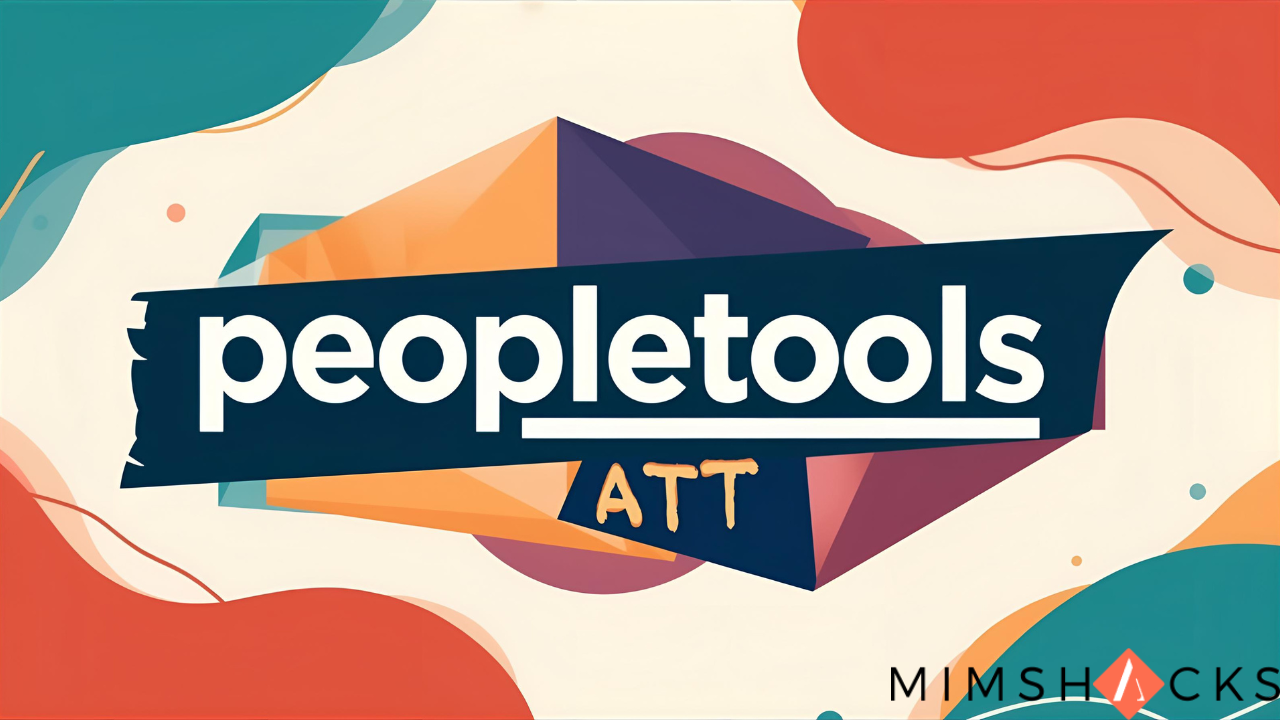PeopleTools ATT – Complete Guide to Oracle’s HR Management Solution
Human resource departments across organizations face mounting pressures to manage employee data, streamline operations, and maintain compliance with evolving regulations.
PeopleTools ATT emerges as a comprehensive solution designed to address these challenges through automated workflows, centralized data management, and integrated analytics capabilities.

What is PeopleTools ATT and How Does It Work
PeopleTools ATT, which stands for Application Technology Tools, represents Oracle’s sophisticated software suite designed specifically for building, customizing, and maintaining PeopleSoft applications.
Rather than operating as standalone software, PeopleTools ATT functions as an integral component within Oracle’s broader PeopleSoft ecosystem, providing organizations with the foundational technology needed to manage complex HR operations effectively.
Developed initially in the early 1990s, this platform has evolved continuously through regular updates and enhancements to meet the changing demands of modern workforce management.
The system serves as the technological backbone for PeopleSoft Enterprise Applications, enabling HR departments to automate processes, integrate multiple systems, and maintain accurate employee records throughout the entire employment lifecycle.
Core Components of PeopleTools ATT System
Understanding the architecture of PeopleTools ATT helps organizations maximize their investment in this technology platform. The suite comprises several interconnected modules that work together to deliver comprehensive HR functionality.
| Component | Primary Function | Key Benefits |
| Application Designer | Interface and database design | Creates custom pages, records, fields, and menus |
| PeopleCode | Custom programming environment | Enables business logic and validation rules |
| Integration Broker | System connectivity | Facilitates data exchange via web services and APIs |
| Process Scheduler | Workflow automation | Manages batch processes and scheduled tasks |
| Query Manager | Data retrieval and reporting | Generates custom reports without coding |
| Data Mover | Database management | Handles data migration and system setup |
PeopleTools ATT Features for Modern HR Operations
Organizations implementing PeopleTools ATT gain access to an extensive feature set designed to transform traditional HR practices into streamlined digital operations.
Automated Workflow Management
The platform eliminates manual intervention in routine processes through intelligent automation capabilities. HR teams can configure workflows that automatically route approval requests, trigger notifications based on specific events, and execute scheduled tasks without constant supervision. This automation extends across recruitment, onboarding, performance management, and offboarding processes.
Advanced Analytics and Reporting
PeopleTools ATT converts raw workforce data into actionable business intelligence. The system provides real-time dashboards that track key performance indicators, identify workforce trends, and support strategic decision-making. HR leaders can generate custom reports that analyze everything from employee engagement levels to training completion rates, enabling data-driven approaches to workforce planning.
Seamless System Integration
Modern organizations rarely operate with a single software system. PeopleTools ATT addresses this reality through robust integration capabilities that connect with enterprise resource planning systems, customer relationship management platforms, payroll processors, and numerous third-party applications. This connectivity ensures data flows smoothly across the entire organizational technology stack.
Security and Compliance Framework
Using technology to protect sensitive information has become paramount in today’s regulatory environment. PeopleTools ATT incorporates role-based access controls, encryption protocols, and comprehensive audit trails that help organizations maintain compliance with data protection regulations including GDPR, CCPA, and industry-specific requirements.
Benefits of Implementing PeopleTools ATT
Organizations choosing PeopleTools ATT experience measurable improvements across multiple operational dimensions.
Operational Efficiency Gains
Automation of repetitive tasks reduces the administrative burden on HR staff by an estimated 30-40%, allowing teams to redirect their efforts toward strategic initiatives. Tasks that previously required hours of manual work, such as generating compliance reports or processing employee data changes, now complete in minutes through automated processes.
Enhanced Data Accuracy
Manual data entry introduces errors that cascade through multiple systems, creating compliance risks and operational inefficiencies. PeopleTools ATT minimizes these errors through automated data validation, standardized entry fields, and centralized record-keeping. Organizations report data accuracy improvements exceeding 95% after implementation.
Cost Reduction Through Automation
While initial investment in PeopleTools ATT requires capital allocation, organizations typically realize significant long-term cost savings. Reduced administrative overhead, decreased error correction expenses, and improved resource allocation contribute to measurable return on investment within 18-24 months of deployment.
Scalability for Growing Organizations
The platform adapts to organizational growth without requiring complete system overhauls. Whether managing 100 employees or 10,000, PeopleTools ATT scales to accommodate expanding workforce requirements while maintaining consistent performance and functionality.
Improved Employee Experience
Self-service portals empower employees to update personal information, access pay stubs, request time off, and view benefits documentation without HR intervention. This accessibility improves employee satisfaction and reduces the volume of routine inquiries directed to HR departments.
Key User Roles for PeopleTools ATT
Different organizational roles interact with PeopleTools ATT in distinct ways, each leveraging specific capabilities aligned with their responsibilities.
| User Role | Primary Responsibilities | Tools Used |
| HR Administrators | Employee data management, policy enforcement | Application Designer, Query Manager |
| System Developers | Custom application development, integration | PeopleCode, Integration Broker |
| Data Analysts | Workforce analytics, trend identification | Query Manager, reporting tools |
| Process Managers | Workflow design, automation configuration | Process Scheduler, Application Designer |
| IT Operations | System maintenance, performance monitoring | All administrative tools |
| End Users (Employees) | Self-service data updates, information access | Employee portal interface |
System Requirements for PeopleTools ATT
Organizations planning PeopleTools ATT implementation must ensure their infrastructure meets specific technical prerequisites.
Hardware Specifications
Optimal performance requires server infrastructure with sufficient processing power and memory allocation. Minimum recommendations include multi-core processors, at least 16GB RAM for development environments, and 32GB or more for production systems. Storage requirements vary based on organizational size and data retention policies, typically ranging from 500GB to several terabytes.
Software Dependencies
The platform operates on multiple database systems including Oracle Database, Microsoft SQL Server, and IBM DB2. Operating system compatibility extends to Windows Server, various Linux distributions, and Unix variants. Web server requirements include support for Oracle WebLogic Server or other compatible application servers.
Network Infrastructure
Reliable network connectivity ensures smooth operation for distributed organizations. Bandwidth requirements scale with user count, with recommendations starting at 100Mbps for small deployments and increasing proportionally for larger implementations.
How to Access PeopleTools ATT Login Portal
Getting started with PeopleTools ATT requires following specific access procedures designed to maintain security while ensuring user convenience.
Initial Setup Process
Organizations typically receive PeopleTools ATT access credentials through their IT department or system administrator. New users should expect to complete the following steps:
- Navigate to the designated PeopleSoft login URL provided by your organization
- Enter your assigned username in the designated field
- Input your secure password following organizational password policy requirements
- Complete multi-factor authentication if enabled by your security team
- Accept any terms of service or usage agreements presented
- Access the main dashboard interface displaying available applications and modules
Password Management Best Practices
Secure access requires strong password creation following industry standards: minimum 12 characters combining uppercase letters, lowercase letters, numbers, and special characters. Organizations should implement regular password rotation policies, typically every 90 days, and enforce account lockout procedures after multiple failed login attempts.
Troubleshooting Common Access Issues
Users experiencing login difficulties should verify network connectivity, confirm correct URL usage, and ensure browser compatibility. Most organizations maintain dedicated support channels through IT helpdesks that can reset passwords, unlock accounts, and resolve technical access barriers.
PeopleTools ATT Implementation Best Practices
Successful deployment of PeopleTools ATT requires strategic planning, thorough testing, and ongoing optimization.
Assessment and Planning Phase
Organizations should conduct comprehensive needs assessments identifying specific pain points, desired functionality, and integration requirements. This phase includes stakeholder interviews, process mapping, and gap analysis comparing current capabilities against desired future state.
Data Migration Strategy
Historical employee data requires careful migration planning to ensure accuracy and completeness. Organizations should establish data cleansing protocols, validation checkpoints, and rollback procedures addressing potential migration issues. Parallel system operation during transition periods helps identify discrepancies before full cutover.
User Training Programs
Investment in comprehensive training maximizes adoption rates and system utilization. Training programs should address different user roles, provide hands-on practice environments, and offer ongoing support resources including documentation, video tutorials, and help desk access.
Change Management Considerations
Technology implementation succeeds or fails based on organizational change management effectiveness. Leadership support, clear communication about benefits, and addressing user concerns proactively contribute to smooth transitions from legacy systems to PeopleTools ATT.
Integration Capabilities with Third-Party Systems
PeopleTools ATT excels at connecting disparate systems within the organizational technology ecosystem.
Enterprise Resource Planning Integration
Seamless connectivity with ERP systems ensures financial data, procurement information, and operational metrics synchronize with HR records. This integration eliminates duplicate data entry and maintains consistency across business functions.
Payroll System Connectivity
Automated data flow between PeopleTools ATT and payroll processors reduces errors and ensures timely, accurate compensation. Employee changes trigger automatic updates to payroll systems, capturing salary adjustments, benefit elections, and tax withholding modifications.
Learning Management System Links
Training and development records integrate directly with employee profiles, providing comprehensive views of skill development, certification status, and compliance training completion. This connectivity supports succession planning and identifies skill gaps requiring attention.
Time and Attendance Tracking
Technology solutions for business operations extend to time tracking integration, automatically capturing work hours, overtime calculations, and leave balances. This data feeds directly into payroll processing and compliance reporting requirements.
PeopleTools ATT vs Traditional HR Systems
Comparing PeopleTools ATT against conventional HR management approaches reveals significant advantages in functionality, flexibility, and future-readiness.
| Aspect | Traditional HR Systems | PeopleTools ATT |
| Data Management | Siloed, manual entry prone to errors | Centralized, automated with validation |
| Reporting Capabilities | Static, predetermined reports | Dynamic, customizable analytics |
| Integration Options | Limited, often requires custom coding | Extensive APIs and pre-built connectors |
| User Interface | Often outdated, complex navigation | Modern, intuitive design |
| Scalability | Requires system replacement as needs grow | Scales within existing framework |
| Mobile Access | Limited or unavailable | Full mobile responsive capabilities |
Real-World Applications and Case Studies
Organizations across industries have realized substantial benefits through PeopleTools ATT implementation.
Healthcare Organization Transformation
A large healthcare network managing over 15,000 employees implemented PeopleTools ATT to address compliance tracking challenges and credential management complexity. Within 18 months, the organization reported 40% reduction in administrative time spent on license verification, 99.8% compliance with regulatory requirements, and significant improvements in employee satisfaction scores related to HR services.
Manufacturing Sector Efficiency Gains
A global manufacturing company utilized PeopleTools ATT to integrate workforce management across 30 facilities in 12 countries. The implementation resulted in standardized processes, 35% reduction in HR staff overtime, and improved data consistency enabling better strategic workforce planning. The organization achieved ROI within 20 months of deployment.
Financial Services Compliance Success
A financial services organization faced stringent regulatory requirements for employee data protection and audit trail documentation. PeopleTools ATT implementation provided the security framework and audit capabilities needed for compliance, while reducing time spent on regulatory reporting by 50% through automated report generation.
Common Challenges and Solutions
Organizations implementing PeopleTools ATT may encounter specific obstacles requiring strategic mitigation approaches.
Data Quality Issues
Legacy systems often contain incomplete or inconsistent employee records. Address this challenge through dedicated data cleansing initiatives before migration, establishing data governance standards, and implementing ongoing data quality monitoring processes.
User Adoption Resistance
Employees comfortable with existing systems may resist change. Combat resistance through comprehensive training, highlighting specific benefits for end users, and maintaining open communication channels for feedback and concerns.
Integration Complexity
Connecting PeopleTools ATT with legacy systems presents technical challenges. Engage experienced integration specialists, prioritize critical integrations, and implement phased approaches rather than attempting simultaneous connection of all systems.
Customization vs Standard Functionality
Organizations must balance customization desires against maintenance complexity. Leverage standard functionality whenever possible, thoroughly document any customizations, and regularly reassess custom code necessity during system updates.
Future Trends in HR Technology and PeopleTools ATT
The evolving technology landscape continues shaping PeopleTools ATT capabilities and organizational expectations.
Artificial Intelligence Integration
AI-powered features increasingly enhance PeopleTools ATT functionality through predictive analytics, automated decision support, and intelligent process optimization. Organizations can expect expanded AI capabilities in areas like candidate screening, performance prediction, and employee engagement analysis.
Enhanced Mobile Functionality
Mobile-first design principles drive ongoing development, enabling comprehensive HR functionality through smartphone and tablet interfaces. Future releases will likely expand mobile capabilities for managers, employees, and HR administrators.
Cloud Migration Trends
While PeopleTools ATT supports both on-premises and cloud deployment models, organizations increasingly favor cloud implementations for reduced infrastructure management burden, automatic updates, and improved disaster recovery capabilities.
Advanced Analytics and Predictive Modeling
Future developments will expand workforce analytics capabilities, enabling organizations to predict turnover risk, identify high-potential employees, and model scenario-based workforce planning with greater accuracy.
How PeopleTools ATT Supports Remote Workforce Management
The shift toward remote and hybrid work models requires robust digital infrastructure supporting distributed teams.
Virtual Onboarding Capabilities
PeopleTools ATT facilitates seamless remote employee onboarding through digital document management, electronic signature capabilities, and automated workflow coordination. New hires complete required paperwork, access policy documentation, and receive necessary credentials without physical office presence.
Remote Performance Management
Manager tools within PeopleTools ATT support remote performance monitoring, goal tracking, and feedback delivery. Regular check-ins, continuous feedback mechanisms, and objective performance metrics help maintain accountability and employee development in virtual environments.
Distributed Team Coordination
The platform enables managers overseeing geographically dispersed teams to maintain visibility into workforce status, track project assignments, and coordinate resources effectively regardless of physical location.
Frequently Asked Questions
How does PeopleTools ATT differ from other Oracle HR products?
PeopleTools ATT serves as the foundational technology layer enabling PeopleSoft applications rather than functioning as a separate HR product. It provides the development environment, integration capabilities, and technical infrastructure supporting Oracle’s PeopleSoft HCM solutions. Organizations implementing PeopleSoft HR modules inherently utilize PeopleTools ATT as the underlying technology platform.
What training is required to use PeopleTools ATT effectively?
Training requirements vary significantly based on user roles. End users accessing employee self-service features typically need only basic orientation covering navigation and common tasks, usually accomplished through 1-2 hour sessions. HR administrators require more extensive training covering data management, reporting, and workflow configuration, typically involving 2-3 days of structured instruction. System developers and technical staff need comprehensive training in PeopleCode programming, application design, and integration techniques, often requiring weeks of formal education and hands-on practice.
Can PeopleTools ATT integrate with existing payroll systems?
Yes, PeopleTools ATT offers extensive integration capabilities supporting connectivity with major payroll processors and custom payroll systems. The Integration Broker component facilitates data exchange through web services, REST APIs, and file-based transfers. Organizations can configure bidirectional data flow ensuring employee changes trigger automatic payroll updates while maintaining data consistency across systems. Pre-built connectors exist for many popular payroll platforms, while custom integration development supports unique requirements.
What are the typical implementation timelines for PeopleTools ATT?
Implementation duration depends on organizational size, complexity, customization requirements, and existing infrastructure. Small organizations with straightforward requirements may complete implementation in 3-6 months. Mid-sized organizations typically require 6-12 months accounting for data migration, integration development, and thorough testing. Large enterprises with multiple locations, complex integrations, and extensive customization needs should anticipate 12-18 months or longer for complete deployment. Phased implementation approaches allow organizations to realize benefits incrementally while managing change effectively.
Does PeopleTools ATT support mobile device access?
Modern versions of PeopleTools ATT include responsive design principles enabling access through smartphones and tablets. Employees can access self-service features, view pay information, submit time-off requests, and update personal data using mobile browsers. The platform automatically adjusts interface elements for optimal display on various screen sizes. Some organizations also implement dedicated mobile applications providing enhanced functionality for specific use cases like time tracking or benefits enrollment.
How does PeopleTools ATT handle data security and compliance?
The platform incorporates multiple security layers including role-based access controls limiting data visibility based on job responsibilities, encryption protecting data both in transit and at rest, comprehensive audit trails tracking all system access and data modifications, and configurable security policies enforcing password complexity and session timeout requirements. These features help organizations maintain compliance with regulations like GDPR, HIPAA, and industry-specific requirements. Regular security updates address emerging threats while maintaining system integrity.
What ongoing maintenance does PeopleTools ATT require?
Successful long-term operation requires regular system maintenance including applying Oracle-released patches and updates addressing security vulnerabilities and functionality improvements, monitoring system performance and optimizing database operations, reviewing and updating security configurations, maintaining integrations with external systems, conducting periodic data quality audits, and providing ongoing user support and training. Organizations typically assign dedicated IT resources to maintenance activities, with requirements scaling based on system complexity and user count.
Can PeopleTools ATT support global operations with multiple languages?
Yes, the platform includes robust internationalization features supporting global deployment. Organizations can configure multiple languages allowing users to access the system in their preferred language. The system handles diverse date formats, currency conversions, and cultural variations in data presentation. Global organizations benefit from standardized processes while accommodating local requirements for legal compliance, benefits administration, and reporting. Time zone management ensures accurate scheduling across distributed operations.





